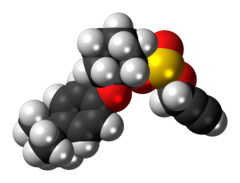Propargite
 | |
 | |
| Names | |
|---|---|
| IUPAC name 2-(4-tert-butylphenoxy)cyclohexyl prop-2-yne-1-sulfonate | |
| Other names Omite, Comite, Uniroyal D014 | |
| Identifiers | |
CAS Number |
|
3D model (JSmol) |
|
| ChEMBL |
|
| ChemSpider |
|
| ECHA InfoCard | 100.017.279 |
| KEGG |
|
PubChem CID |
|
| UNII |
|
CompTox Dashboard (EPA) |
|
InChI
| |
| |
| Properties | |
Chemical formula | C19H26O4S |
| Molar mass | 350.47 g·mol−1 |
| Appearance | dark amber viscous liquid |
| Density | 1.10 g/cm3 |
Solubility in water | 0.5 ppm |
| Solubility | miscible in organic solvents |
| Hazards | |
| Safety data sheet (SDS) | Cornell University |
Except where otherwise noted, data are given for materials in their standard state (at 25 °C [77 °F], 100 kPa). Infobox references | |
Chemical compound
Propargite (IUPAC name 2-(4-tert-butylphenoxy)cyclohexyl prop-2-yne-1-sulfonate, trade names Mitex, Omite and Comite) is a pesticide used to kill mites (an acaricide).[2] Symptoms of excessive exposure are eye and skin irritation, and possibly sensitization. It is highly toxic to amphibians, fish, and zooplankton, as well as having potential carcinogenity.[3]
References
- ^ Lide, David R. (1998), Handbook of Chemistry and Physics (87 ed.), Boca Raton, Florida: CRC Press, pp. 3–482, ISBN 978-0-8493-0594-8
- ^ a b "propargite (Omite, Comite) Chemical Fact Sheet 9/86". Cornell University. 1986-09-30. Retrieved 2009-12-02.
- ^ "Integrated Risk Information System". 2013-03-15.
http://onlinelibrary.wiley.com/doi/10.2903/j.efsa.2011.2087/epdf
External links
- Propargite in the Pesticide Properties DataBase (PPDB)
- v
- t
- e











